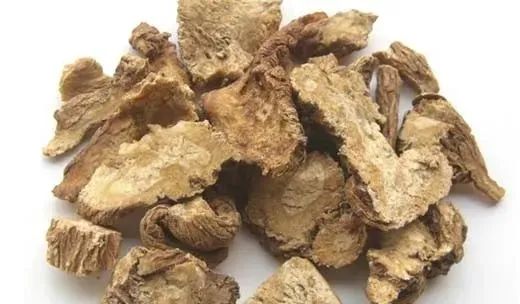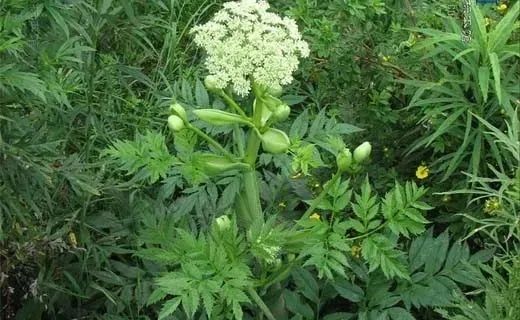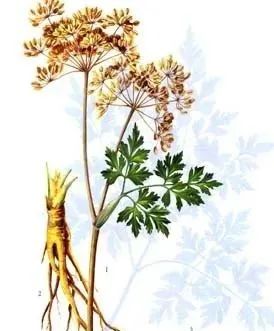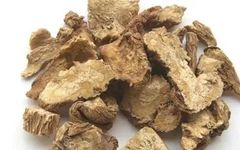Providing you with knowledge on health and wellness
First, please follow us to prevent not finding us next time
to prevent not finding us next time

Angelica Sinensis (Dang Gui) is a commonly used Chinese medicinal herb. It was first recorded in the Shen Nong Ben Cao Jing (Shen Nong’s Classic of Materia Medica) and classified as a medium-grade herb.
Alias: Qin Gui, Xi Gui.
Source: The dried root of the perennial herb Angelica Sinensis from the Apiaceae family. Cultivated varieties.
Production Areas: Mainly produced in areas such as Min County, Dangchang, Wudu, Xihe, Lixian, and Wushan in Gansu Province; also produced in Yunnan, Sichuan, Shaanxi, Hubei, and Guizhou.

Identification: The main root is cylindrical or conical, with several to over ten lateral roots that are slightly twisted. The total length is 10-25 cm, with the main root measuring 2-7 cm in length and 2-3 cm in diameter, and the top diameter can sometimes reach 3.5 cm. The upper end of the lateral roots has a diameter of about 1 cm, tapering towards the end. The top has a distinct base scar, which is slightly convex or flat, often with residual basal leaves. The skin is brownish or light brown, with the upper end of the main root having indistinct annular wrinkles, and the entire root has tight longitudinal wrinkles and slightly raised pores. It is hard, softening and becoming pliable after absorbing moisture, with a cross-section that is yellowish-white or light yellow-brown, exhibiting radial texture, commonly referred to as “chrysanthemum heart”; the cambium is dark brown and annular. The xylem and phloem contain numerous small fissures and yellow-brown secretion cavities, with a white pith sometimes present at the center. It has a distinctive aromatic scent, with a slightly bitter and slightly spicy taste.

The best quality is characterized by a long, thick main root, few but robust lateral roots, a yellow-brown surface, and a cross-section that is powdery white or light yellow-white.
Main Components: Contains volatile oils and a component that stimulates the uterus; also contains sucrose, vitamin B12, etc.
Efficacy and Functions of Angelica Sinensis (Dang Gui)
Functions: Nourishes blood, promotes blood circulation, moistens the intestines, regulates menstruation.
1. Adjusts uterine function. Animal experiments have confirmed that when the uterus is under internal pressure, Angelica Sinensis has a stimulating effect on the uterus, making contractions regular and strengthening their force; when there is no internal pressure, it has an inhibitory effect on the uterus.
2. Sedative and analgesic effects. The effective component is the volatile oil.
3. Diuretic effect. The effective component is sucrose.
4. Anti-vitamin E deficiency.
5. Antibacterial effects. In vitro tests show inhibitory effects on dysentery bacillus, typhoid bacillus, E. coli, and hemolytic streptococcus.
Preparation: Sliced for raw use or stir-fried with wine, stir-fried with earth, or charred.
Taste and Properties: Sweet, bitter, spicy, warm.
Meridians Entered: Heart, Liver, Spleen.
Functions: Nourishes blood, invigorates blood circulation, regulates menstruation, moistens dryness, and lubricates the intestines.
Indications: Irregular menstruation, blood deficiency or blood stasis leading to amenorrhea, dysmenorrhea, metrorrhagia, traumatic injuries, abscesses, rheumatic pain, and constipation due to blood deficiency.
Clinical Applications: Angelica Sinensis is one of the most commonly used herbs in TCM. It is used for nourishing blood and promoting circulation, applicable to all conditions of blood deficiency, deficiency syndromes, exterior syndromes, and abscesses.
1. A key herb in gynecology, primarily used for regulating menstruation, with good efficacy for dysmenorrhea, often combined with Bai Shao (White Peony) and Yan Hu Suo (Corydalis). It also treats amenorrhea and irregular menstruation. In summary, various menstrual regulation formulas cannot do without Angelica Sinensis, as it has blood-moving and analgesic effects (either enhancing uterine contractions to expel stagnant blood or relaxing uterine spasms to relieve pain), often combined with Shu Di Huang (Rehmannia), Chuan Xiong (Ligusticum), and Bai Shao to form the Si Wu Decoction. This is a fundamental formula for regulating blood, suitable not only for blood deficiency but also for various syndromes of irregular menstruation and postpartum conditions, which can generally be adjusted based on this formula.
2. Used for nourishing blood. For symptoms of heart blood deficiency such as palpitations, forgetfulness, insomnia, and anxiety, Angelica Sinensis nourishes blood to calm the spirit, as in the Dang Gui Bu Xue Decoction; for symptoms of spleen blood deficiency leading to emaciation and sallow complexion, it nourishes blood to strengthen the spleen, as in the Si Wu Decoction; for symptoms of liver blood deficiency causing dizziness, tinnitus, and muscle spasms, it nourishes blood to soften the liver, as in the Yi Guan Jian Decoction.
3. Used to treat blood stasis in the limbs, especially for traumatic injuries and vascular diseases causing blood stasis or poor circulation and swelling. Angelica Sinensis has a blood-moving effect (improving circulation and relieving pain), hence it is commonly used in formulas for traumatic injuries and for treating thrombotic occlusive vascular diseases.
4. Used to treat abdominal pain, particularly suitable for abdominal pain due to qi and blood stasis combined with deficiency-cold, such as postpartum abdominal pain, often combined with Jian Zhong Decoction to enhance warming and pain-relieving effects, as in the Dang Gui Jian Zhong Decoction, or it can be used in Dang Gui Sheng Jiang Yang Rou Tang (Angelica Sinensis, Ginger, and Lamb Soup); if it is due to stasis (such as early dysentery with bloody diarrhea and abdominal pain or constipation-related abdominal pain in women), it can be combined with Bai Shao and Xiang Fu for blood-moving and analgesic effects, as in the Dang Gui Shao Yao San with modifications.
5. Used to treat chronic abscesses, taking advantage of its blood-moving, blood-nourishing, and pain-relieving effects to improve circulation and enhance the body’s resistance, often combined with Huang Qi (Astragalus) and Yin Hua (Honeysuckle).
6. Used to treat dry intestines and constipation, particularly suitable for those with qi and blood deficiency, often combined with other herbs that nourish and promote bowel movements, such as Rou Cong Rong (Cistanche) and Niu Xi (Achyranthes), as in the Ji Chuan Decoction.
Additionally, for exterior syndromes with qi and blood deficiency, or headaches and joint pain due to blood stasis, Angelica Sinensis can also be used for its blood-moving and analgesic effects.
Usage Precautions: 1. It has been said: “The head of Angelica nourishes blood, the body nourishes blood, and the tail breaks blood, all are used for invigorating blood”; or “the head nourishes the head (including neck and chest), the body nourishes the body, and the tail nourishes the limbs”. However, in practice, it is not necessary to be rigid. In clinical applications, the commonly sold Angelica Sinensis is generally supplied as whole roots. If conditions permit, it can be subdivided according to the following principles: for improving blood circulation or when used in exterior-releasing formulas, whole Angelica Sinensis is better; for treating anemia and regulating menstruation, the body part is preferable; for treating traumatic swelling and joint mobility issues, the tail part is better.
2. Long-term or excessive use of Angelica Sinensis may cause deficiency heat to rise, resulting in symptoms such as sore throat and nasal burning; in such cases, it is advisable to add cooling and blood-clearing herbs, such as Yin Hua and Sheng Di (Rehmannia) to adjust.
3. Angelica Sinensis promotes bowel movements, so it is not suitable for those with spleen and stomach yang deficiency leading to diarrhea; if one usually has loose stools and needs to use Angelica Sinensis, it is advisable to add Bai Zhu (Atractylodes) and Fu Ling (Poria) to counteract its laxative effect.
4. Angelica Sinensis is warm in nature, so it is not suitable for those with lung deficiency and internal heat, or for those who have just stopped vomiting blood.
Methods of Using Angelica Sinensis
Dosage: The common dosage is 9-12 g, preferably slightly higher, up to 12-30 g; for large doses, it can be used up to 60 g, while for exterior syndromes, a small amount of 3-9 g is sufficient; for nourishing blood and improving blood circulation or constipation, such as in the Dang Gui Sheng Jiang Yang Rou Tang for postpartum blood deficiency, the dosage of Angelica Sinensis is above 30 g, but in the Dang Gui Bu Xue Tang, only 6 g of Angelica Sinensis is used to assist Huang Qi (this formula is named “nourishing blood”, but it actually nourishes qi to generate blood).
Example Formulas: 1. Dang Gui Bu Xue Tang (Angelica Sinensis Blood Nourishing Decoction) from Nei Wai Shang Bian Huo Lun: Angelica Sinensis 6 g, Huang Qi 30 g, decoct in water for oral administration.
2. Yi Guan Jian (One-String Decoction) from Liuzhou Yi Hua: Angelica Sinensis 9 g, Bei Sha Shen (North American Ginseng) 9 g, Mai Dong (Ophiopogon) 6 g, Sheng Di 24 g, Gou Qi Zi (Goji Berries) 12 g, Chuan Lian Zi (Melia Toosendan) 4.5 g, decoct in water for oral administration.
3. Dang Gui Jian Zhong Tang (Angelica Sinensis and Ginger Decoction) from Qian Jin Yi Fang: Angelica Sinensis 12 g, Gui Zhi (Cinnamon Twig) 6 g, Bai Shao 12 g, Gan Cao (Licorice) 9 g, Sheng Jiang 3 g, Hong Zao (Red Dates) 15 g, Yi Tang (Rock Candy) 30 g (dissolved), decoct in water for oral administration.
4. Dang Gui Sheng Jiang Yang Rou Tang (Angelica Sinensis, Ginger, and Lamb Soup) from Jin Gui Yao Lue: Lamb 250 g, Angelica Sinensis 30 g, Ginger 15 g, steamed in water, taken warm, or decoct in water for oral administration.
5. Dang Gui Shao Yao San with modifications: Angelica Sinensis 9 g, Bai Shao 12 g, Chuan Xiong 6 g, Bai Zhu 9 g, Fu Ling 9 g, Ze Xie 9 g, Xiang Fu 6 g, Yan Hu Suo 6 g, decoct in water for oral administration.
6. Ji Chuan Jian (Benefit the River Decoction) from Jing Yue Quan Shu: Angelica Sinensis 12 g, Niu Xi 6 g, Rou Cong Rong, Ze Xie 4.5 g, Sheng Ma 2.4 g, Zhi Ke 3 g, decoct in water for oral administration.
Note: The product specifications have varied in the past, such as Hu Shou Gui, Yuan Lai Tou, Chang Xing Gui, Gui Tui, Gui Wei, etc., but are now simplified into grades 1-4 for Angelica Sinensis and grades 1-4 for the head, classified by the size of the roots. Grade 1 Angelica Sinensis has 20 roots per 0.5 kg or less, grade 2 has 33 roots or less, grade 3 has 55 roots or less, and grade 4 has more than 55 roots but no more than 70% of the tail. The head of Angelica Sinensis (Hu Shou) has grade 1 with 20 roots or less, grade 2 with 40 roots or less, grade 3 with 60 roots or less, and grade 4 with 80 roots or less.
This product is from Gansu, known for its good quality, with long main roots, fine skin, and solid texture. The Yunnan product has short, thick main roots, coarser skin, and a slightly inferior quality. Additionally, some regions also produce local Angelica Sinensis for local sale.
Providing you with knowledge on health and wellness
First, please follow us to prevent not finding us next time
to prevent not finding us next time
Recommended Reading
-
Summary of the Efficacy of Chinese Herbs (Most Comprehensive)
-
The Best Dietary Therapy for Strengthening the Spleen and Stomach, Passed Down for Over Three Hundred Years!
-
The Amazing Chinese Herb: The Efficacy and Functions of Yi Mu Cao (Motherwort)

